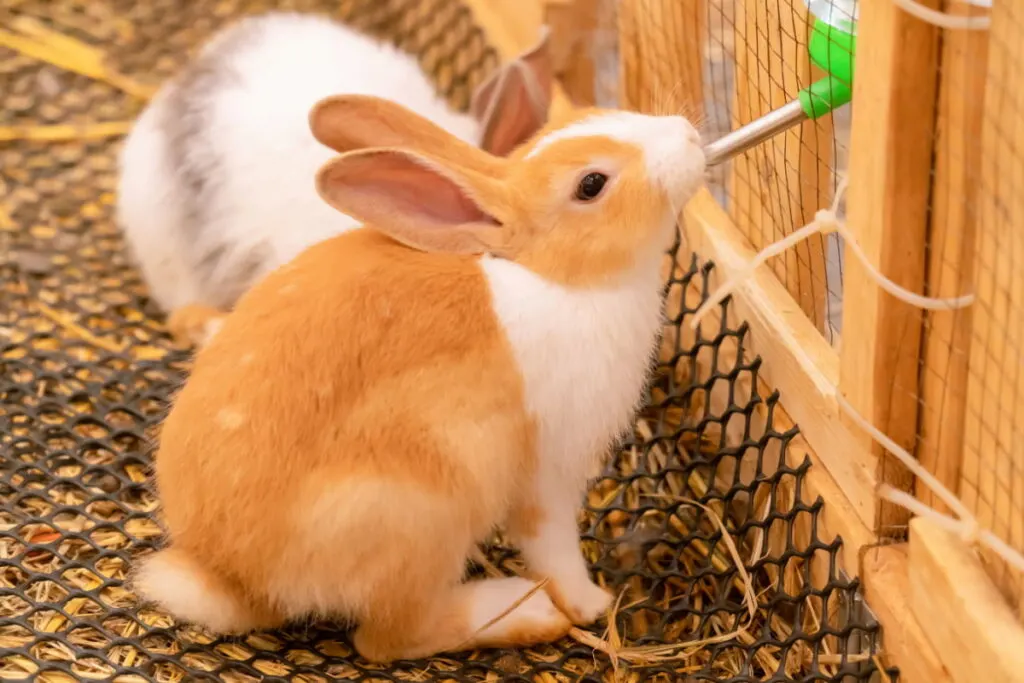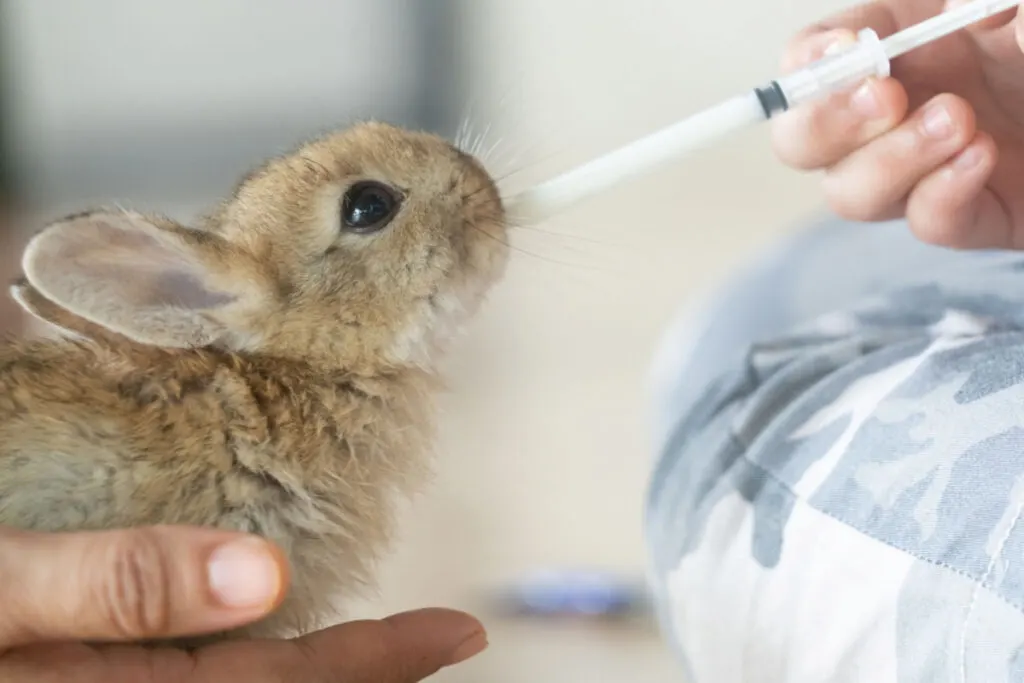Under normal circumstances, rabbits will drink water in response to thirst. But sometimes, some rabbits just never seem to drink enough water.
Knowing how important water is to any living organism, you may be wondering how you can get your rabbit to drink water. Well, in this article, we have a couple of tips for getting your rabbit to drink water.

Table of Contents
Make the Water More Accessible
When rabbits are sick, injured, or stressed, they may have trouble reaching their water. This is especially true when the water source is not very close to its resting spot.
In such a case, to get your rabbit to drink water, move the water closer to the corner it spends most of its time in.
Ensure the Water Is Clean
Rabbits will only drink water that is suitable for consumption. So, ensure that the water you offer your rabbit is clean.
The type of water you may consider clean may not be clean to your rabbit. The rabbit might taste or smell something that turns it off – things that human senses may not perceive.
So, to increase the chances of your rabbit accepting the water, wash its bowl and bottle thoroughly with rabbit-safe cleaning products. Then get water from the cleanest source, filter it, then serve it to your rabbit.
After doing the above, if your rabbit still refuses to drink water, get the water tested. If the water contains chemicals like fluoride or lead, your rabbit may never drink it.
Use Purified Water or Bottled Water
If you have confirmed that your water contains high levels of certain chemicals, you may have to switch to cleaner water sources. At this point, try getting bottled water or purified water for your rabbit.
Replace Its Water Frequently
After a few hours, your rabbit’s leftover water might seem okay to you, but to the rabbit, it isn’t. Rabbits do not like stale water.
Water that has been left untouched for a few hours would be tainted with dust and dirt. Some bacteria may have started to grow in the water, too. When these happen, your rabbit may refuse to drink the water.
So, to encourage your rabbit to drink more water, ensure you replace its water at least 2-3 times a day.

Provide a Water Bowl and a Water Bottle
Although water bowls are more natural for rabbits, providing them with a water bowl and a water bottle can improve their water drinking rate.
The deal is to give your rabbit multiple choices. If it prefers the water bottle, it gets the water bottle, and if it fancies the water bowl, it gets the water bowl.
Talking about choices, you could get an electric fountain water bowl for your rabbit. This type of bowl keeps water from getting stale. So, you may not have to replace the water frequently.
There is a chance that your rabbit might flip its water bowl and mess its living space up. To prevent this, get a heavy ceramic or metal bowl.
One word of caution, never get your rabbit a plastic water bowl; it may just chew the bowl. But considering how delicate a bunny’s stomach is, chewing plastic might make them sick.
You could smear some watermelon or banana on the sipper of the water bottle to encourage your rabbit to drink more water. But if you do this, never forget to clean off remnants of the fruits before they start rotting.
Whether you provide a water bowl, a water bottle, or both, always ensure you keep them clean. As long as these items remain uncontaminated, the water in them should be fit for your rabbit.
Leave the Residual Water on Its Leaves and Greens
Before offering any vegetable or fruit to your rabbit, you must wash them with clean water. But after doing that, do not shake the residual water off the vegetable or fruit completely.
As your rabbit consumes the leaves, vegetables, or fruits, it will swallow the residual water. This is another way to increase your bunny’s water consumption.

Offer the Rabbit More Fruits and Vegetables With High Water Content
To increase water consumption in your rabbit, you can offer them more vegetables and fruits with high water content.
Vegetables like celery, watercress, and lettuce have high water content. While celery should only be given sparingly, the other two can be given to rabbits regularly.
Fruits like watermelon, peach, and veggies such as zucchini and cucumber have high water content. You can give your rabbit cucumbers and zucchinis regularly. But watermelon and peach should come in at 1-2 times a week.
Add Some Unsweetened Fruit or Vegetable Juice to the Water
Adding minimal amounts of unsweetened fruit juice or vegetable juice to the water can get your rabbit to drink more.
The juice will add some flavor to the water, and the rabbit will be more inclined to drink.
Never give your rabbit juice made with additives, as it may upset the rabbit’s stomach. Ensure you only give it 100% fruit or vegetable juice.
Some juice options to try are 100% carrot juice, 100% pineapple juice, or 100% apple juice. Remember to add only a few drops of any of these juices to the water. Too much may affect your rabbit’s diet.
Add Some Fragrant Herbs to the Water
In place of unsweetened fruit or vegetable juice, you could add fragrant herbs to your rabbit’s water. The strong scent of such herbs will attract your rabbit to the water. And as it tries to get the herb out of the water, it will drink some water.
Herbs like basil, mint, or dill should work for this purpose. Thankfully, they can be fed to rabbits regularly.
Bring the Water to Room Temperature
Bunnies are sensitive to many things, and water temperature is one of those things. Rabbits typically avoid cold, warm, or hot water. Most of them prefer water at room temperature. So, before you offer water to your rabbit, try bringing it to room temperature.

Feed the Rabbit With a Syringe or an Eyedropper
If your rabbit is not drinking any water at all, you may try feeding it with a syringe or an eyedropper.
With the bunny on your lap, place a few drops of water on its lips. If the rabbit licks the water off, continue with this method. While doing this, encourage the bunny by gently stroking its body. You could also praise it softly.
If the bunny does not lick the water off its lips, pop the syringe or eyedropper in its mouth through the side. Then introduce a single drop into its mouth. Do not rush the administration of the water as the rabbit may aspirate. If the bunny still does not drink water after this, head to the vet.
Final Take
While trying any of the tips above, you should try sitting with the bunny. While with the rabbit, monitor its behavior for anything unusual. If you notice something strange, report to the vet immediately. Whatever you detect may just be a sign of an illness that must be treated right away. Following proper treatment, your bunny may just return to drinking water as it should.
